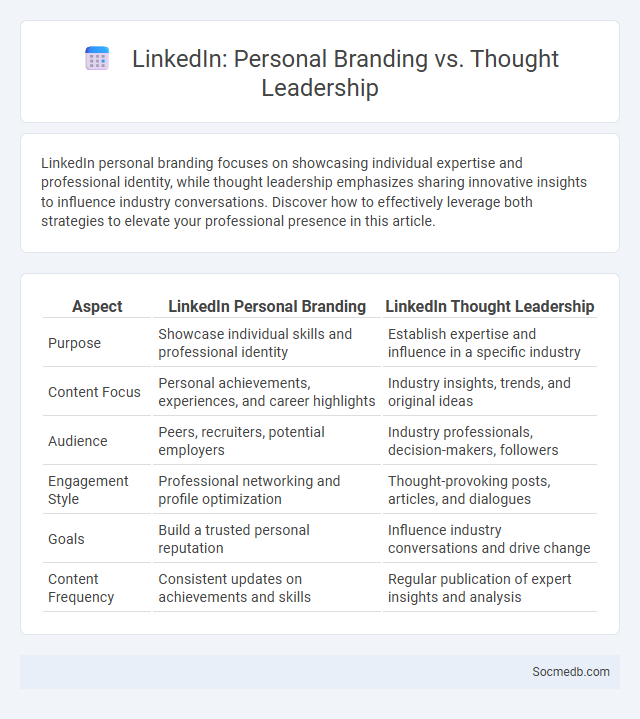
Photo illustration: LinkedIn Personal Branding vs Thought Leadership
LinkedIn personal branding focuses on showcasing individual expertise and professional identity, while thought leadership emphasizes sharing innovative insights to influence industry conversations. Discover how to effectively leverage both strategies to elevate your professional presence in this article.
Table of Comparison
| Aspect | LinkedIn Personal Branding | LinkedIn Thought Leadership |
|---|---|---|
| Purpose | Showcase individual skills and professional identity | Establish expertise and influence in a specific industry |
| Content Focus | Personal achievements, experiences, and career highlights | Industry insights, trends, and original ideas |
| Audience | Peers, recruiters, potential employers | Industry professionals, decision-makers, followers |
| Engagement Style | Professional networking and profile optimization | Thought-provoking posts, articles, and dialogues |
| Goals | Build a trusted personal reputation | Influence industry conversations and drive change |
| Content Frequency | Consistent updates on achievements and skills | Regular publication of expert insights and analysis |
Understanding LinkedIn Personal Branding
Understanding LinkedIn personal branding is essential for establishing your professional identity and expanding your network. By optimizing your profile with relevant keywords, showcasing your expertise through thoughtful content, and engaging with industry peers, you effectively position yourself as a trusted authority in your field. Your consistent presence and authentic interactions on LinkedIn can lead to increased visibility, career opportunities, and business growth.
Defining Thought Leadership
Thought leadership on social media involves establishing Your expertise and authority in a specific niche by consistently sharing valuable insights and innovative ideas that resonate with your audience. It requires creating content that not only informs but also inspires meaningful conversations, positioning You as a trusted voice in Your industry. Building thought leadership effectively drives engagement, brand loyalty, and opens opportunities for collaboration and growth.
What is Personal Branding?
Personal branding is the strategic process of creating and managing an individual's online presence to establish a unique identity and reputation. It involves consistently showcasing expertise, values, and personality across social media platforms to attract a targeted audience and build trust. Effective personal branding enhances career opportunities, networking potential, and influence in a chosen industry.
Key Differences: LinkedIn Personal Branding vs. Thought Leadership
LinkedIn personal branding centers on showcasing individual skills, career achievements, and professional personality to build a distinct identity that attracts job opportunities and networking connections. Thought leadership on LinkedIn involves consistently sharing insightful, industry-specific content to establish authority, influence trends, and inspire trust among peers and potential clients. Personal branding emphasizes self-presentation and reputation management, while thought leadership prioritizes expertise demonstration and value-driven content creation.
Overlapping Elements Among Branding Approaches
Overlapping elements among branding approaches on social media include consistent visual identity, unified messaging, and cohesive storytelling that reinforce brand recognition. Your social media strategy should integrate logo usage, color schemes, and tone of voice across platforms to create a seamless brand experience. These shared components enhance audience trust and engagement by delivering a clear, memorable brand presence.
Advantages of LinkedIn Personal Branding
LinkedIn personal branding enhances professional visibility by showcasing expertise, skills, and achievements to a targeted audience of industry peers and recruiters. It facilitates networking opportunities, connecting individuals with potential employers, collaborators, and thought leaders, thereby expanding career prospects. Consistent and authentic online presence on LinkedIn builds trust and credibility, positioning users as influential voices within their professional fields.
Building Authority Through Thought Leadership
Establishing authority on social media involves consistently sharing insightful, data-driven content that addresses industry challenges and trends. Engaging with followers through meaningful discussions and showcasing expertise via webinars, articles, and case studies boosts credibility and fosters trust. Strategic use of targeted hashtags and collaborations with influencers amplifies reach, positioning individuals or brands as thought leaders within their niche.
Crafting an Authentic Personal Brand
Crafting an authentic personal brand on social media involves showcasing genuine values and consistent messaging that resonates with your target audience. Engaging through transparent storytelling and meaningful interactions fosters trust and loyalty, enhancing online reputation. Leveraging platforms like Instagram and LinkedIn to highlight real experiences and expertise increases visibility and strengthens personal brand credibility.
Best Practices for Combining Approaches
Integrating organic content strategies with paid social media advertising enhances overall campaign effectiveness by leveraging authentic engagement while targeting specific audiences through data-driven ads. Utilizing audience insights and performance metrics from multiple platforms allows marketers to optimize budget allocation and content scheduling for maximum reach and conversion. Consistent brand messaging and cross-channel coordination ensure a seamless user experience that drives higher ROI and strengthens brand loyalty.
Choosing the Right Strategy for Your Career
Selecting the right social media strategy for your career involves identifying platforms where your target audience is most active, such as LinkedIn for professionals or Instagram for creative industries. Tailoring content to showcase your expertise and engage your network with consistent posting and authentic interactions enhances your personal brand's visibility. Measuring engagement metrics and adjusting your approach based on analytics ensures your efforts align with your career goals.
 socmedb.com
socmedb.com